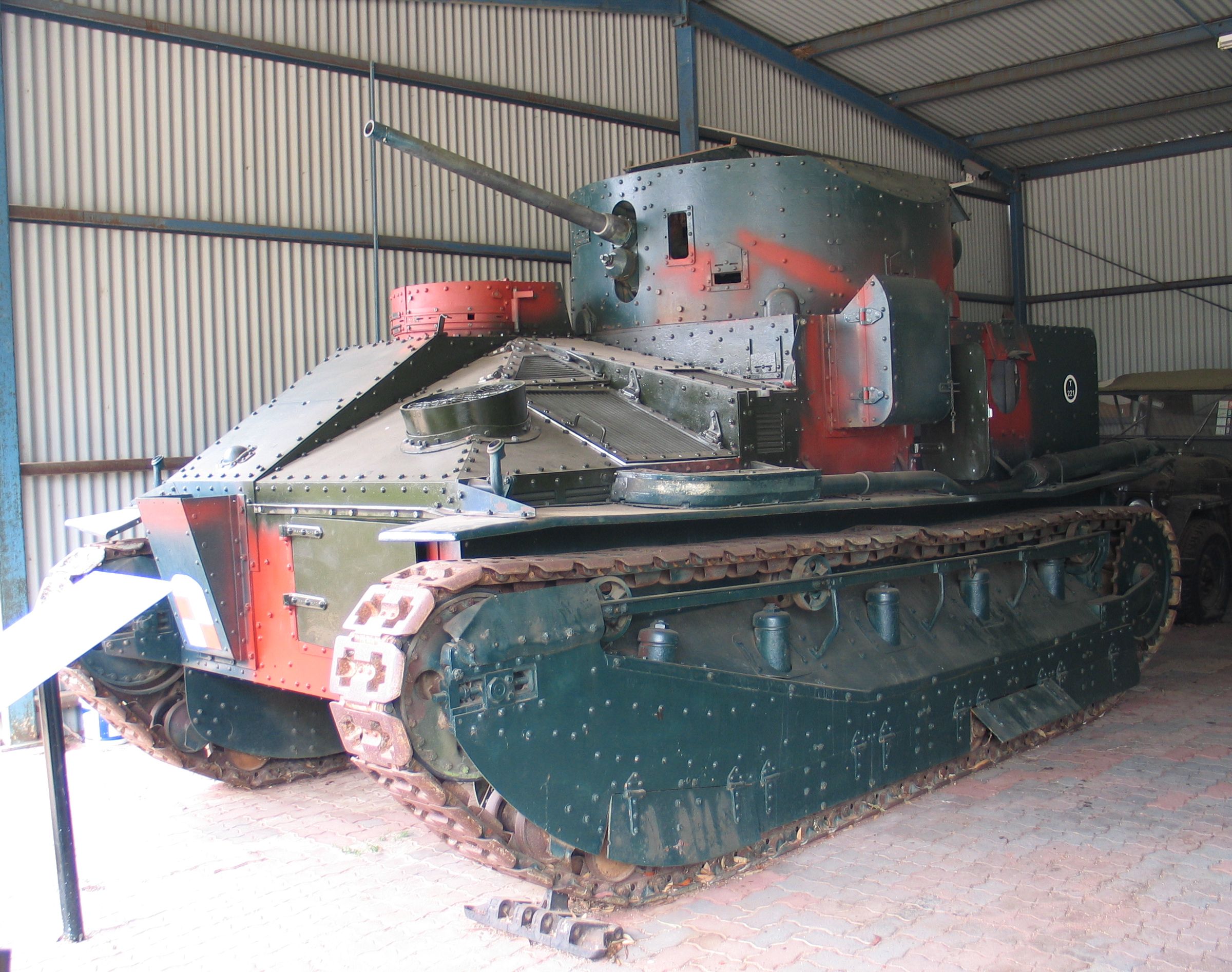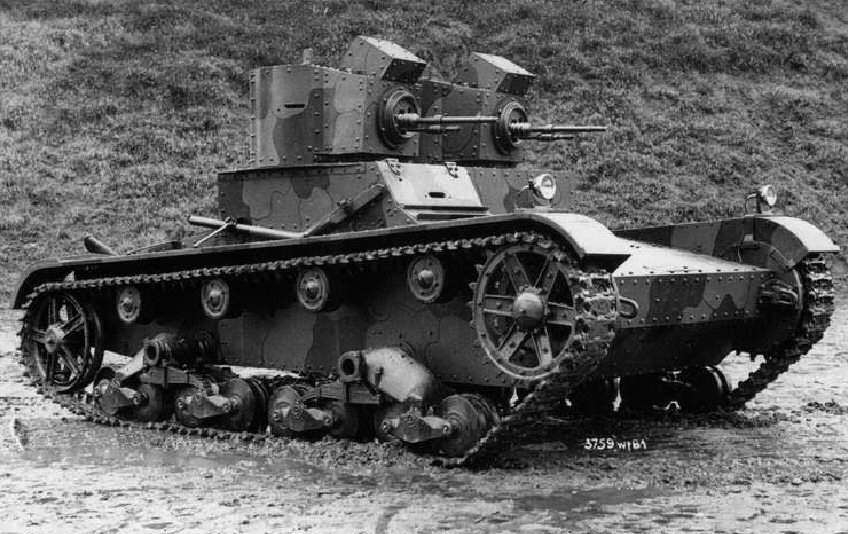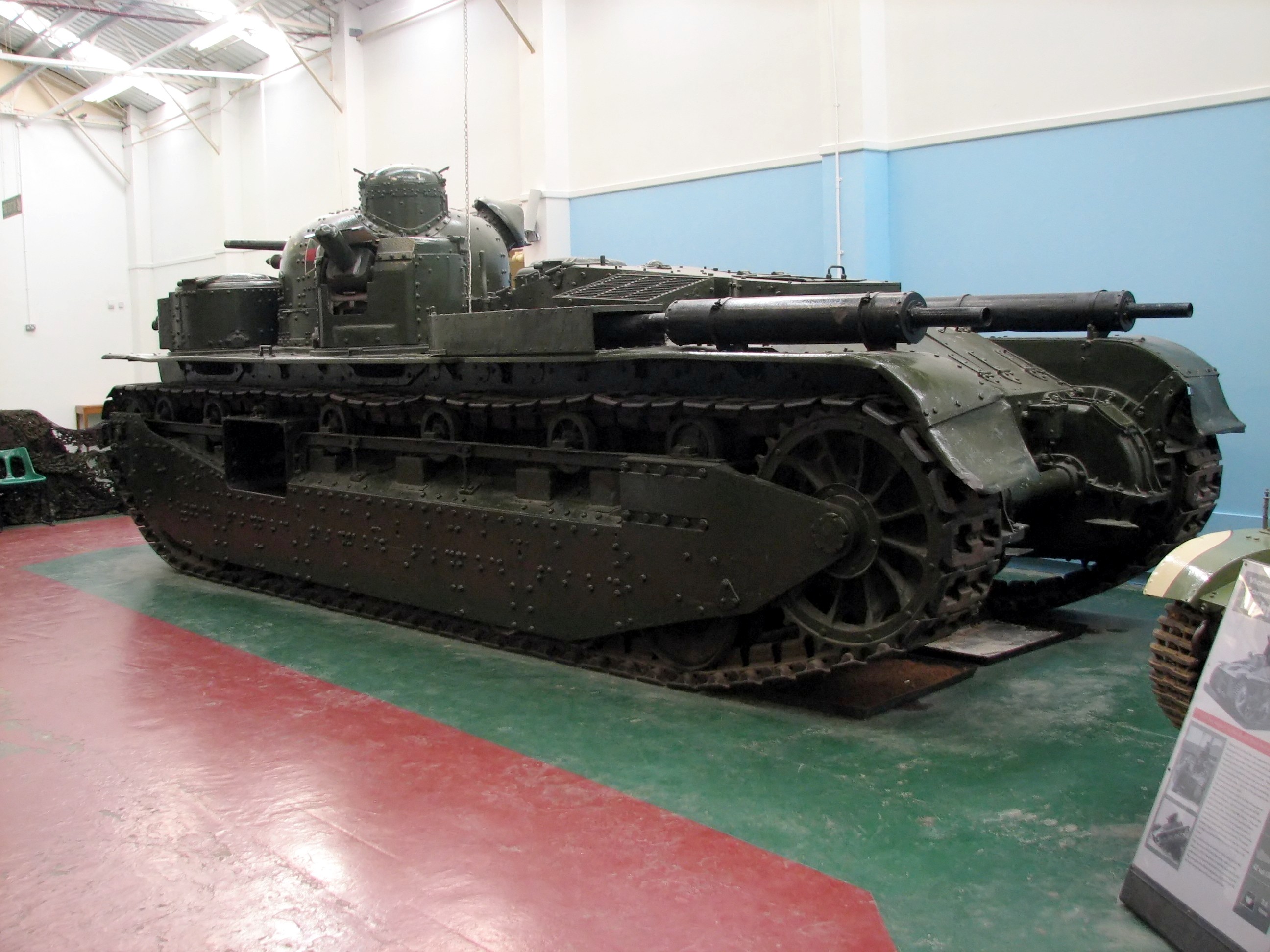|
OQF 3-pounder Gun
The Ordnance QF 3 pounder 2 cwt gun was a 47 mm British tank gun based on the Ordnance QF 3 pounder Vickers naval gun, mounted on Vickers-built tanks in the 1920s and 1930s. The gun was produced in 31 calibre (59 inch) and 40 calibre (74 inch) versions. The weapon only fired a solid shot, and was stated in the requirements of the A6 series of Vickers Medium tanks to have the ability to penetrate the armour of contemporary hostile tanks at a range of 1000 yards. The Vickers Medium Mark I was equipped with the Ordnance Quick Firing 2cwt Mark I version of the weapon, whilst from the Vickers Medium Mark II the Mark II version of the 3-pounder was utilized. Even though other European countries still fielded similar weapons (e. g., Cannone da 47/32) at the start of the Second World War (and quite a few years into it), due to its comparatively low muzzle velocity the 3-pounder was considered obsolete by the war start by the British, with the Ordnance QF 2-pounder replacing it as the ... [...More Info...] [...Related Items...] OR: [Wikipedia] [Google] [Baidu] |
Vickers Medium Mark II
The Vickers Medium Mark II was a British tank built by Vickers in the Inter-war period. The Medium Mark II, derived from the Vickers Medium Mark I, was developed to replace the last of the Medium Mark Cs still in use. Production and rebuilding ran from 1925 until 1934. The tank was phased out of service from 1939, replaced by the Cruiser Mk I. It featured several improvements over the Vickers Mark I: a higher superstructure with the driver's visor on top of it instead of in front of it; an improved suspension protected by armour skirts; and Rackham clutches, providing a primitive form of mechanical servo-control. Due to a slightly higher weight its rated speed was somewhat slower than that of the Medium Mark I, at compared to . Design The Mark II used the same chassis, suspension and transmission as the Medium Mark I but had a new superstructure. The Mark II was equipped with a 47 mm 3 pdr gun and four machine guns in the turret. The back of the turret had a slope so that ... [...More Info...] [...Related Items...] OR: [Wikipedia] [Google] [Baidu] |
Medium Mark III
The Medium Mark III was a medium tank developed in the United Kingdom during the Interwar period. The prototypes of the Medium Mark II were the three A6 also known as "16-tonner" tanks. From the tests of the A6, three Mark IIIs were built and put into service with the British Army but due to the high cost no more were purchased. Development A6 "Sixteen tonners" In 1926, the British War Office wanted to replace their existing Mark II tanks with a new design. In May the Royal Tank Corps Centre was asked for its opinion, which it submitted in July. One of the requirements was a weight limit of , which led to the nickname "16-tonners". Other specifications included that it could transported by rail, a sufficient supply of lubrication oil to match the range of the tank (dictated by the fuel carried), a wireless set, a gun capable of defeating enemy armour at a range of at least , fuel tanks external to the main compartments and bottom armour sufficient to withstand heavy machi ... [...More Info...] [...Related Items...] OR: [Wikipedia] [Google] [Baidu] |
World War II Artillery Of The United Kingdom
In its most general sense, the term "world" refers to the totality of entities, to the whole of reality or to everything that is. The nature of the world has been conceptualized differently in different fields. Some conceptions see the world as unique while others talk of a "plurality of worlds". Some treat the world as one simple object while others analyze the world as a complex made up of many parts. In ''scientific cosmology'' the world or universe is commonly defined as " e totality of all space and time; all that is, has been, and will be". '' Theories of modality'', on the other hand, talk of possible worlds as complete and consistent ways how things could have been. ''Phenomenology'', starting from the horizon of co-given objects present in the periphery of every experience, defines the world as the biggest horizon or the "horizon of all horizons". In ''philosophy of mind'', the world is commonly contrasted with the mind as that which is represented by the mind. ''Th ... [...More Info...] [...Related Items...] OR: [Wikipedia] [Google] [Baidu] |
World War II Tank Guns
In its most general sense, the term "world" refers to the totality of entities, to the whole of reality or to everything that is. The nature of the world has been conceptualized differently in different fields. Some conceptions see the world as unique while others talk of a "plurality of worlds". Some treat the world as one simple object while others analyze the world as a complex made up of many parts. In ''scientific cosmology'' the world or universe is commonly defined as " e totality of all space and time; all that is, has been, and will be". '' Theories of modality'', on the other hand, talk of possible worlds as complete and consistent ways how things could have been. ''Phenomenology'', starting from the horizon of co-given objects present in the periphery of every experience, defines the world as the biggest horizon or the "horizon of all horizons". In ''philosophy of mind'', the world is commonly contrasted with the mind as that which is represented by the mind. ''Th ... [...More Info...] [...Related Items...] OR: [Wikipedia] [Google] [Baidu] |
47 Mm Artillery
47, 47 or forty-seven may refer to: *47 (number) *47 BC *AD 47 *1947 * 2047 *'47 (brand), an American clothing brand * ''47'' (magazine), an American publication * 47 (song), a song by Sidhu Moose Wala *47, a song by New Found Glory from the album ''Not Without a Fight'' *"Forty Seven", a song by Karma to Burn from the album '' V'', 2011 * +47, the international calling code for Norway *4seven, a television channel *Agent 47, protagonist of the ''Hitman'' video game series *''47'', a young adult novel by Walter Mosley See also * List of highways numbered 47 * Channel 47 (other) * M47 (other), including "Model 47" (M47) * Forty-seven Ronin (other) * A47 (other) A47 may refer to: * Queen's Indian Defense, ''Encyclopaedia of Chess Openings'' code * Focke-Wulf A.47, a meteorological aircraft developed in Germany in 1931 ; roads * A47 road, a road connecting Birmingham and Lowestoft in England ... * Capital Steez {{number disambiguation ... [...More Info...] [...Related Items...] OR: [Wikipedia] [Google] [Baidu] |
List Of Tank Main Guns ...
This is a list of tank main guns which are designed or used as the primary weapon of combat by tanks, such as light tanks, medium tanks, heavy tanks, or main battle tanks. Many tanks have other, secondary weapons installed in them, such as machine guns, autocannons and small calibre mortars, which are not included in this list. Also excluded from this list are weapons installed in self-propelled artillery vehicles such as assault guns or tank destroyers that usually lack turrets. This is due to the unique nature of turreted tank tactics, their design, and operation. List of tank guns See also *Tank gun Notes {{reflist References Tank A tank is an armoured fighting vehicle intended as a primary offensive weapon in front-line ground combat. Tank designs are a balance of heavy firepower, strong armour, and good battlefield mobility provided by tracks and a powerful engin ... [...More Info...] [...Related Items...] OR: [Wikipedia] [Google] [Baidu] |
Vickers 6-Ton
The Vickers 6-ton tank or Vickers Mark E, also known as the "Six-tonner" was a British light tank designed as a private project at Vickers. It was not adopted by the British Army, but was picked up by many foreign armed forces. It was licensed by the Soviet Union as the T-26. It was also the direct predecessor of the Polish 7TP tank. History The first Mark E was built in 1928 by a design team that included the famed tank designers John Valentine Carden and Vivian Loyd. The hull was made of riveted steel plates, thick at the front and over most of the turrets, and about thick on the rear of the hull. The power was provided by an Armstrong Siddeley engine of (depending on the version), which gave it a top speed of on roads. The Horstmann suspension used two axles, each of which carried a two-wheel bogie to which a second set of bogies was connected with a leaf spring. Upward movement of either set of bogies would force the other down through the spring. This was considered ... [...More Info...] [...Related Items...] OR: [Wikipedia] [Google] [Baidu] |
Vickers A1E1 Independent
The Independent A1E1 is a multi-turreted tank that was designed by the British armaments manufacturer Vickers between the First and Second World Wars. Although it only ever reached the prototype stage and only a single example was built, it influenced many other tank designs. The A1E1 design can be seen as a possible influence on the Soviet T-100 and T-28 tanks, the German '' Neubaufahrzeug'' tanks, and the British Medium Mk III and Cruiser Mk I (triple turret) tank designs. The Soviet T-35 tank was heavily influenced by its design. Design The Independent was a multi-turret design, having a central gun turret armed with the 3 pounder (47 mm) gun, and four subsidiary turrets each armed with a 0.303 inch Vickers machine gun. The subsidiary turrets were mounted two at the front and two to the rear of the turret (about halfway along the hull). The gun of the left rear turret was able to elevate to engage aircraft. The tank was designed to have heavy firepower, self-defence capabi ... [...More Info...] [...Related Items...] OR: [Wikipedia] [Google] [Baidu] |
Vickers Medium Mark I
The Vickers Medium Mark I was a British tank of the Inter-war period built by Vickers from 1924. Background After the First World War Britain disbanded most of its tank units leaving only five tank battalions equipped with the Mark V and the Medium Mark C. At first a large budget was made available for tank design but this was all spent on the failed development of the Medium Mark D. When the government design bureau, the ''Tank Design Department'', was closed in 1923 any direct official involvement in tank development was terminated. However private enterprise in the form of the Vickers-Armstrong company built two prototypes of a new tank in 1921. Vickers Light Tank In 1920 the Infantry had plans to acquire a Light Infantry Tank. Colonel Johnson of the Tank Design Department derived such a type from the Medium Mark D. In competition Vickers built the Vickers Light Tank. The Vickers design still was reminiscent of the Great War types. It had a high, lozenge-shaped, track fram ... [...More Info...] [...Related Items...] OR: [Wikipedia] [Google] [Baidu] |
Puckapunyal
Puckapunyal (more formally the Puckapunyal Military Area, but also known as the Puckapunyal Camp or Puckapunyal Army Base, and colloquially as "Pucka") is an Australian Army training facility and base 10 km west of Seymour, in central Victoria, south-eastern Australia.Dennis et al. (eds.), ''The Oxford Companion to Australian Military History'', p. 435 Description Puckapunyal is a small restricted-access town inhabited mainly by about 280 families of the Australian Defence Force community, with an associated area of about 400 km2 of bushland and former pasture used for field training exercises. It is home to the Australian Army's School of Armour, the School of Artillery and the School of Transport, along with the Combined Arms Training Centre, the Joint Logistics Unit, and two transport squadrons. The Royal Australian Armoured Corps Memorial and Army Tank Museum is on the base's grounds, and the facilities are used by the Victorian Australian Army Cadets Brigade. ... [...More Info...] [...Related Items...] OR: [Wikipedia] [Google] [Baidu] |
Ordnance QF 2-pounder
The Ordnance QF 2-pounder ( QF denoting "quick firing"), or simply "2 pounder gun", was a British anti-tank gun and vehicle-mounted gun employed in the Second World War. It was the main anti-tank weapon of the artillery units in the Battle of France and, due to the need to rearm quickly after the Dunkirk evacuation, remained in service during the North African campaign. In its vehicle-mounted variant the 2-pounder was a common main gun on British tanks early in World War II, as well as being a typical main armament of armoured cars, such as the Daimler, throughout the war. As the armour protection of Axis tanks improved, the 2-pounder lost effectiveness and it was gradually replaced by the 57 mm QF 6-pounder starting in 1942. It equipped infantry battalion anti-tank platoons replacing their anti-tank rifles until in turn replaced by 6-pounders but remained in service until the end of the war. This QF 2-pounder was distinctly different from the QF 2 pounder "pom-pom" gun ... [...More Info...] [...Related Items...] OR: [Wikipedia] [Google] [Baidu] |
Cannone Da 47/32
The Cannone da 47/32 mod. 1935 was an Italian artillery piece that saw service during World War II. It was originally designed by Austrian firm Böhler, and produced in Italy under license. The ''Cannone da 47/32'' was used both as an infantry gun and an anti-tank gun at which it was effective against light to medium armored tanks. History The Austrian firm of Böhler originally designed and manufactured the gun. In the 1930s Italy bought some of these guns from Böhler, and then began to produce the weapon under license, continuing its development. The Cannone da 47/32 M35 was the main armament in the M13/40 medium tank, the M14/41 medium tank, and experimentally on the AB 41 armored car (see photograph), and the 47/32 self-propelled gun. The 47/32 was built in two versions, the first with semi-pneumatic disk wheels, and the second (in 1939, from which the name 47/32 mod. 39) with improved barrel and suspension (in some series also light-alloy wheels with semi-pneumatic t ... [...More Info...] [...Related Items...] OR: [Wikipedia] [Google] [Baidu] |








